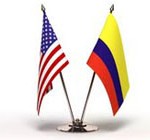 The FTA between the U.S. and Colombia whose implementing bill was approved on October 12, 2011, becomes effective on May 15, 2012. With this, more than eighty percent of US exports of consumer and industrial products to Colombia will become duty-free. The products cut across sectors ranging from agriculture to aerospace. In 2011, goods exports totaled $14.3 billion. The U.S. International Trade Commission has estimated that it will lead to an increase in US GDP of $2.5 billion.
The FTA between the U.S. and Colombia whose implementing bill was approved on October 12, 2011, becomes effective on May 15, 2012. With this, more than eighty percent of US exports of consumer and industrial products to Colombia will become duty-free. The products cut across sectors ranging from agriculture to aerospace. In 2011, goods exports totaled $14.3 billion. The U.S. International Trade Commission has estimated that it will lead to an increase in US GDP of $2.5 billion.
Under the terms of the agreement, the U.S.–Colombia Trade Promotion Agreement (TPA) will support more American jobs, increase U.S. exports, and enhance U.S. competitiveness:
- Colombia’s economy is the third largest in Central and South America. This comprehensive trade agreement will eliminate tariffs and other barriers to U.S. exports, expand trade between our two countries and promote economic growth for both.
- The International Trade Commission (ITC) has estimated that the tariff reductions in the Agreement will expand exports of U.S. goods alone by more than $1.1 billion, supporting thousands of additional American jobs. The ITC also projected that the Agreement will increase U.S. GDP by $2.5 billion.
- The Agreement will provide significant new access to Colombia’s $166 billion services market, supporting increased opportunities for U.S. service providers.
- U.S. goods exports to Colombia in 2010 were $12.0 billion. Our economies are largely complementary in terms of the goods we ship each other. For example, Colombia is a large importer of grains from the United States while it exports a number of tropical fruits to our country. In addition, U.S. cotton, yarn and fabric exports to Colombia are used in many apparel items that Colombia exports to the United States.
As with all bilateral or regional free trade agreements, there will be rules of origin that govern what goods can be entered (for import purposes) and what the minimum origin content from each country is in order to qualify. Further, the agencies who govern things such as agriculture or pharmaceuticals will have their specific requirements for goods to be admitted to those markets as well. The implementing rules which govern all facets of the agreement are available on the website of the Office of the U.S. Trade Representative.

